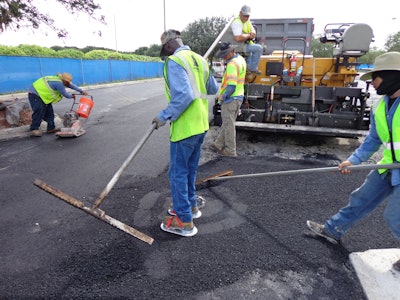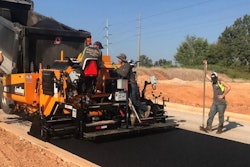
Luting freshly placed hot mix asphalt is done on every paving project, making the asphalt lute the most-common hand tool on paving jobs. Sometimes a paving job needs two lute guys: one for the joint you’re matching and one for work against concrete on the other side of the paver.
Luting is an art. It’s not simple and it’s not easy – but it can be the difference between a great paving job and one that either doesn’t look good or doesn’t last long – or both. It’s not a skill that anybody can just grab and try to lute.
In fact, luting is very much like raking (most luters start out on the rake). But where raking is moving mounds of material, luting is the “fine tuning” of the asphalt mat. It involves taking off the stone and manipulating the mat to eliminate imperfections.
So the lute man needs a light touch and a skilled eye. He (or she) will either help produce a quality mat on the job or – if he is too heavy handed or if he works the mat too much -- the job will be worse when he gets done. The lute should not drag on or into the mat, instead it should float on the mat, much like leveling of concrete.
Handling the Lute
The lute man is usually the “spotter” on the paving crew. He is charged with inspecting the mat and recognizing where there’s a “high spot” that he can shave off to give the mat a nice finish. Or if he spies a low spot that will puddle in the rain he can call for a shovel full of mix to fill it in.
A right-handed lute man typically places his left hand low on the bottom of the lute handle and the right hand near the top of the lute handle. The handle stays perpendicular to the arm, which enables the lute operator’s forearm to have touch of the lute so the lute angle doesn’t vary. The handle is always in touch with the forearm so wherever the forearm goes the lute follows, always at the same angle.
Where one crew member handles a shovel to add mix to low spots, the lute is used as a leveling tool. In fact, lutes are often used in conjunction with a straight edge to make sure the surface is flat. The lute man’s job is to get all the good product he can out of each shovel full by pushing and pulling the mix back and forth and repeating. The lute man massages the hot mix asphalt so the fine materials fill in the hole and the larger material comes to the top where you can pull it off. The lute man wants to blend that shovel full of mix with the rest of the mat.
When you pull off excess material either push it off onto the unpaved gravel or the worker with the shovel comes and picks it up and puts it away. Do not put it back in the paver because that mix has already been stripped of its properties; you don’t want to reuse the mix.
The Lute Tool
As for the lute itself, the hand tool is available in a variety of sizes and types. A typical lute blade is serrated on one side with a straight edge on the other. This enables the lute user to roughen the surface with the serrated edge and flip the tool and do smoothing with the other side.
Lutes are available made of wood or aluminum, and lute size is often a matter of personal preference. Lutes are available in 2-ft.-wide versions but the most-common lute found on a paving crew is 36 in. x 3 in. with 8-ft. handle. A 3-ft. lute is most common one because it’s easier to blend the mix into the mat better when working in 3-ft sections than if you’re working in 2-ft. sections. You just can’t blend it as nicely if you’re working in smaller areas.
Lutes are also available with a variety of handle lengths but long handles are better because you can reach farther without walking onto the mat. (In fact, the lute man often wears tamp shoes so he can walk on the mat without leaving footprints.) Lutes tend to get hot so some people wear gloves when handling a lute. Other people don’t like to wear gloves because they can’t get the feel of the lute when wearing gloves.
Lute Maintenance
When working in the field it’s common for excess asphalt to build up inside the blade when pulling it and outside the blade when pushing the material. To reduce this build-up all lutes should be sprayed with a release agent to lubricate the blade, making it easy for the mix to slide off. In addition it’s a good idea for the operator to carry a putty knife in a sheath attached to his belt. The putty knife blade should be stiff and measure 1-1/2 in. wide and can be used to scrape off excess asphalt that doesn’t slide off the blade.
A good lute handler is not always just “busy, busy, busy” because you don’t want to work the mix if it doesn’t need it and you don’t want to overwork the mix even when it does need it. So if you have lute guy who’s busy all the time, your paver operator needs to do a better job or you need to find something else for your lute man to do.
John S. Ball is president of Top-Quality Paving, P.O. Box 4398, Manchester, NH 03104; [email protected]. He is also an annual speaker at National Pavement Expo, which will be held Feb. 7-10, 2018 in Cleveland.











![Lee Boy Facility 2025 17 Use[16]](https://img.forconstructionpros.com/mindful/acbm/workspaces/default/uploads/2025/09/leeboy-facility-2025-17-use16.AbONDzEzbV.jpg?ar=16%3A9&auto=format%2Ccompress&fit=crop&h=135&q=70&w=240)








